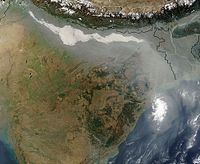
Photo from wikipedia
Severe daily ambient PM2.5 concentrations (> 400 μg m-3 ) have been recorded in Delhi for about 50 days in the post-monsoon seasons (October to November) between 2016 to 2019.… Click to show full abstract
Severe daily ambient PM2.5 concentrations (> 400 μg m-3 ) have been recorded in Delhi for about 50 days in the post-monsoon seasons (October to November) between 2016 to 2019. Monthly average ambient PM2.5 concentration during the period followed the order: September (63.0 ± 3.6 μg m-3 ) < October (145.8 ± 7.3 μg m-3 ) < November (233.0 ± 11.5 μg m-3 ). Crop residue burning has been reported as one of the major sources of ambient PM2.5 in Delhi during the period. This study analysed the impact of meteorological parameters and crop residue burning on the ambient PM2.5 concentration in Delhi during the period, using the dataset from one of the official monitoring stations, HYSPLIT air parcel back trajectory model, and satellite-based active fire dataset for the year 2016 to 2019. The study suggests that crop residue burning events at Sangrur, Mansa, Bhatinda, Patiala, Ludhiana, Barnala, and Patiala (0.5o × 0.5o grid size) districts attribute to the severe PM2.5 concentration in Delhi during November. A significant negative relationship of daily PM2.5 concentrations with the meteorological parameters [Wind speed (r2 = -0.36, p<0.05), planetary boundary layer height (r2 = -0.45, p<0.05)] and positive relationship with the crop residue burning event (r2 = 0.46, p<0.05) that occurred three days earlier, was recorded. This study can help policymakers undertake location-specific actions based on meteorological forecasts to reduce the cost and improve the effectiveness of policy actions to reduce the impact of crop residue burning on the ambient PM2.5 concentration of Delhi during the post-monsoon season. This article is protected by copyright. All rights reserved.
Journal Title: Journal of environmental quality
Year Published: 2022
Link to full text (if available)
Share on Social Media: Sign Up to like & get
recommendations!